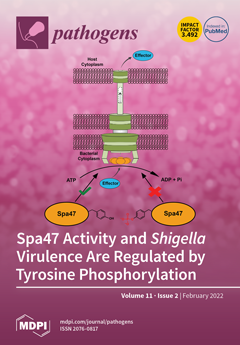Plague, caused by the human pathogen
Yersinia pestis, is a severe and rapidly progressing lethal disease that has caused millions of deaths globally throughout human history and still presents a significant public health concern, mainly in developing countries. Owing to the possibility
[...] Read more.
Plague, caused by the human pathogen
Yersinia pestis, is a severe and rapidly progressing lethal disease that has caused millions of deaths globally throughout human history and still presents a significant public health concern, mainly in developing countries. Owing to the possibility of its malicious use as a bio-threat agent,
Y. pestis is classified as a tier-1 select agent. The prompt administration of an effective antimicrobial therapy, essential for a favorable patient prognosis, requires early pathogen detection, identification and isolation. Although the disease rapidly progresses and the pathogen replicates at high rates within the host,
Y. pestis exhibits a slow growth in vitro under routinely employed clinical culturing conditions, complicating the diagnosis and isolation. In the current study, the in vitro bacterial growth in blood cultures was accelerated by the addition of nutritional supplements. We report the ability of calcium (Ca
+2)- and iron (Fe
+2)-enriched aerobic blood culture media to expedite the growth of various virulent
Y. pestis strains. Using a supplemented blood culture, a shortening of the doubling time from ~110 min to ~45 min could be achieved, resulting in increase of 5 order of magnitude in the bacterial loads within 24 h of incubation, consequently allowing the rapid detection and isolation of the slow growing
Y. pestis bacteria. In addition, the aerobic and anaerobic blood culture bottles used in clinical set-up were compared for a
Y. pestis culture in the presence of Ca
+2 and Fe
+2. The comparison established the superiority of the supplemented aerobic cultures for an early detection and achieved a significant increase in the yields of the pathogen. In line with the accelerated bacterial growth rates, the specific diagnostic markers F1 and LcrV (V) antigens could be directly detected significantly earlier. Downstream identification employing MALDI-TOF and immunofluorescence assays were performed directly from the inoculated supplemented blood culture, resulting in an increased sensitivity and without any detectable compromise of the accuracy of the antibiotic susceptibility testing (E-test), critical for subsequent successful therapeutic interventions.
Full article






